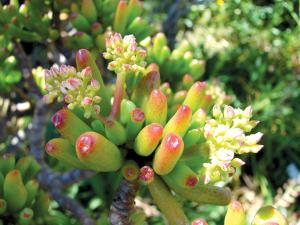Succulents can beat the summer heat nicely
It’s summer and it’s hot. So hot that even the Eiffel tower grows six inches taller every summer because the heat expands the metal. What with vacations and all, many plants just don’t make it over the summer. Some plants, however, are built for the heat and the lack of water. The aptly named succulent plants store water in their leaves, stems and roots.
Probably the best known succulents are cacti (family: Cactaceae), but many other familiar plants are succulents including jade plants (Crassula ovata), aloe vera, agaves, sempervivums, sedums, aloes, kalanchoes and echeverias. Succulents have an unbelievable variety of appealing leaf forms and plant shapes. You can find succulents with flat paddle leaves, firm rosettes and even trailing leaves.
Succulents make excellent display plants in dish gardens. You can plant succulents in between stones in walls or paths, in between patio pavers, in rock gardens and on the rocks themselves. Because of their shallow roots, you can fit several in a wide, shallow dish that you can move around for instant color.
All succulents have very similar growing needs. Outdoors, succulents prefer full sunlight. Indoors put them in bright light; a south-facing window is ideal. That said, some succulents will burn if they are suddenly put in direct sunlight.
By the same token, succulents in poor light tend to stretch, forming lanky stems and widely spaced leaves.
Succulents can take more cold than you might think. In their native deserts and plains, the nights can drop to freezing.
Even though water storage is their trademark, water your succulents liberally in the summer. Let the soil dry out between waterings. In the winter, when the plants are dormant, only water every other month. Overwatering is probably the most common cause of death.
Pot up your succulents in a fast-draining soil mixture such as cactus potting soil. You can make your own by adding sand or perlite to allow air in and increase drainage.
You can fertilize succulents during the summer growing season, using a weak liquid plant food. Never fertilize during the winter. Most succulents will thrive in poor soil without any fertilizer. Because succulents store so much water in their leaves, leaf cuttings are a good way to grow new plants. Break off a leaf and let it dry to form a callous over the cut.
This coating acts like a scab and seals the cut end of the leaf, which prevents dehydration. It may take a few days or even a week for the callous to form. Once the leaf is calloused over, simply put the leaf cut end down into cactus potting soil. Place the potted cuttings in a bright light out of direct sun. Only water the cuttings when the soil feels dry to the touch.
Hardy succulents can stay outdoors all winter as long as the soil doesn't get too moist and they're sheltered from drying winds. Succulents are great way to enjoy gardening without spending your summer watering and caring for your garden plants. They ask only for bright sun and an occasional drink. Or was that the gardener?




















































